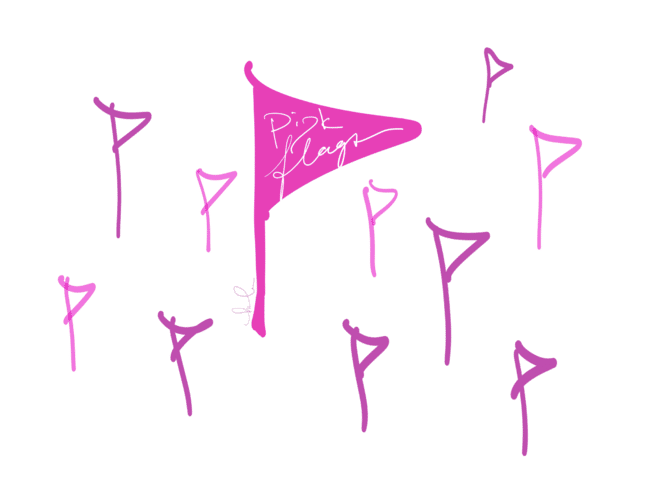You know what a red flag is. Warning, danger, “bad gut feeling”, something was said or done which is an indicator this (whatever ‘this’ is) will not go well.
Prospective client or team member, new client relationship, business opportunity such as a merger or sale. In any of these (and many other) situations we stay alert to red flags and can often identify them clearly as such. Even one red flag can be enough to end the whole thing.
Another kind of flag which has helped me and the team (and now our clients) over the years is a pink flag.
They’re not so obvious as red flags, and in and of themselves they’re not dangerous.
If there’s only one or two, and in the grand scheme of things you have loads of green flags, things might end up being okay. But when there are multiple pink flags taken together, they can become a wildly waving red flag which you didn’t see initially.
With pink flags you usually know which direction it’s going because of the situation or explanation you get later.
For example, if a prospect cancels a booked call last minute with no explanation, you might think “hmmm, pink flag – that seems rude not to send even an email or a text”. But if they email later and say “I’m so sorry – my dad literally went into hospital and I had to rush him there, we’re here now, could we rebook”, then you recognise it as an exceptional situation and honour the fact they were transparent about the reason and wrote as soon as they could.
How they go on from there, and depending how the next meeting goes, will help you determine what to do with your pink flag.
Let’s say the prospect actually didn’t write you at all. You chased them up and they said “oh i got really busy – could we rebook?”, it’s your decision what to do with that. You might rebook the meeting whilst holding onto that as a pink flag. If they miss the next meeting, or show up late, or aren’t attentive, you’ve got more pink flags. With enough of them, you call it at that point and tell them it doesn’t look like a fit.
Pink flags move your observation from a gut feel to something which is tangible, noticed, even documented.
There’s still a judgment call involved, but with a pink flag you are recognising this behaviour as potentially unacceptable. You either hold on to it until you see if there is an accumulation (and then you make a judgment call), or you let it go because everything else was good.
Pink flags are extremely useful in your hiring process.
A pink flag gives grace.
It recognises sometimes things don’t go perfectly, and you’re willing to be open, to give the benefit of the doubt. We looked at hiring someone who said and did a few things we weren’t sure about, but we marked them as pink flags because there were cultural differences we wanted to honour and be aware of. It could be, we said, this thing which seems rude or hesitant is actually simply a cultural difference, and once we understand that we’ll have learned things too. And they could be the perfect fit for this role.
In the end it turned out all the pink flags (which began to accumulate more heavily towards the end of the hiring process) were in fact real issues – small ones – which indicated this wasn’t a fit for PF. Recognising them as pink flags helped us to make the call quickly and more objectively at the end, rather than saying “well, we feel badly, this person has spent so much time and so have we, maybe it will work out”. We saw how the pink flags combined together, we knew it wasn’t right, and we called it.
Pink flags help you to give space, and equally they help you not to drag it all out. Red flags are easy to spot because they’re so dramatic, so drastic, so serious. The person who refused to complete a tester project as part of our hiring process – that’s a red flag. Clear cut, simple. The person who had a problem with their tester project – pink flag. We weren’t sure at first whether it was on them or us (or both). Turned out it was on us, and we had some settings wrong. The prospect still got the project done on time, even with the adjusting required, which removed the pink flag.
When you’re trying to decide if something is a pink flag or a red flag, you can ask yourself a few questions:
- Do I know why this bothers me? Where does it come from? What am I basing this on?
- What are my/our clear, documented values and how does this measure up against those?
- Am I the only one who sees it, or have others mentioned it too?
- Is there a pattern here? Is there more than one of these flags?
- What alerted me to this flag? How did I notice it?
- If I was to be the most generous I could possibly be, is there potentially a good reason for this action or behaviour?
- Is there potentially a cultural reason for this action which I don’t yet understand? How can I find out if this is the case?
Sometimes asking (and answering) even one of these questions will show the flag for what it is.
One of PF’s values is “Take responsibility”. If a potential team member says “I didn’t get this tas done in time because I got really busy at work and I had to pick up my child from school”, the flag goes up because we know our values, and this doesn’t fit the responsibility value. If they say “I got it done on time, and here it is”, and you find out later they got really busy and their child had to be picked up but they still managed to figure out a way to do it, you see they took responsibility for their life and schedule and family. Perhaps even with a bonus of the transparency value, which we define as “sharing the right things at the right time to build relationship”. It wouldn’t have been the right time to share it defensively, saying “my life is super hard but i got this done anyway”. But later as a looking back, sharing how it felt to be them and to go through the process at that time, shows responsibility.
Your flags will be different from anyone else’s: and they will often be different every time. The more you get in the habit of noticing pink flags, the clearer you will become on what makes a pink flag, what makes a red flag…and all of this will help you see those beautiful flowing green flags which tell you this is going to be the best opportunity ever.
What can you identify as a pink flag right now with a prospect, client, or in another relationship?



